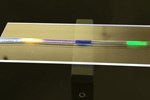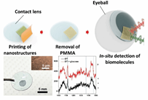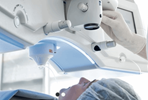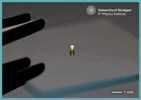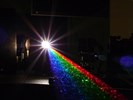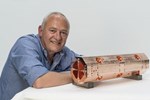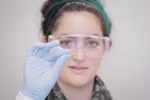ARTICLES BY SUZANNE HODSDEN
-
Could Fiber Optic Probes Replace Traditional Biopsies?5/1/2017
Successfully miniaturized multimodal optical technology combines three nonlinear imaging techniques into one probe, said German scientists.
-
Minimally-Invasive Brain Imaging May Be Possible With Surgical Needles3/22/2017
By substituting a glass surgical needle for the endoscope, a proof-of-concept study in mice has demonstrated technology that might lead to a minimally invasive method for imaging deep brain tissue, one that could provide a better understanding of neurological conditions.
-
Fiber Optics May Provide Minimally Invasive Alternative To Traditional Muscle Biopsy3/6/2017
New technology may provide a minimally invasive alternative to traditional muscle biopsies, which are commonly used to diagnose patients showing symptoms of muscular disorders, diseases, or infections.
-
New 'Smart Needle' Guides Surgeons Through Safer Brain Surgeries1/24/2017
Novel needle technology developed at the University of Adelaide (UA) uses a tiny fiber optic camera and infrared light to guide neurosurgeons through dangerous procedures. Computer software connected to the needle can recognize blood vessels and alert the surgeon, preventing a potentially life-threatening bleed.
-
First Real-Life Study Tests Feasibility Of Solar-Powered Implants1/5/2017
Researchers in Switzerland have produced real-life evidence that implanted devices could one day be powered by solar energy. Study participants who wore solar power measurement devices throughout their regular daily activities generated the energy required to power the average contemporary pacemaker, regardless of the weather, season, or age.
-
Stretchy Optical Fibers Could Detect Disease10/24/2016
Optical fibers designed using biocompatible hydrogel could play a role in next-generation, flexible biosensors, according to scientists at Harvard University and MIT. By tracking the quality of light shining through the stretchy fibers, researchers could use the technology in implantable or wearable devices to monitor muscle mobility, tumor growth, or inflammation over time.
-
“Smart” Contact Lens Uses Optical Biosensing To Detect Glucose9/30/2016
Scientists at the University of Houston (UH) have developed a new approach to glucose-sensing contact lenses by integrating an optical sensor. Though the correlation between glucose levels in tear samples and traditional blood samples is not yet established, the researchers said that their “smart” contact lens prototype demonstrates the versatility of their biosensing technology and a possible non-invasive alternative to existing glucose monitors.
-
FDA Approves Zeiss' Less Invasive Laser System For Nearsightedness9/15/2016
The FDA has approved the VisuMax Femtosecond Laser for small incision lenticule extraction (SMILE) procedures, which are indicated for the correction of nearsightedness in patients age 22 and older. Carl Zeiss Meditec (Zeiss) developed the SMILE procedure as a less-invasive alternative to LASIK and PRK surgery.
-
3D-Printed Camera Small Enough To Be Injected Through a Syringe7/1/2016
German scientists have produced a camera, using additive manufacturing with a femtosecond laser printer, capable of building free-form optics. Researchers claim that technology opens possibilities for micro- or nano-optical devices, such as endoscopes and mini-robots with autonomous vision, and paves the way for a “paradigm shift” in medical imaging that could be injected into the body through a syringe.
-
New Graphene Lasers Show Potential For Surgery And Spectroscopy8/11/2015
Graphene Flagship scientists have developed a graphene-based optical fiber laser capable of emitting ultrashort pulses using only a few wave lengths of light, which could prove useful in biomedical applications. Ultrafast spectroscopy would allow for greater image resolution than has ever been achieved, and surgical lasers using shorter pulses could reduce heat damage to living tissue.
-
CERN Miniaturizes Linear Accelerator For Medical Applications7/31/2015
Scientists from the European Organization for Nuclear Research (CERN) have taken the technology used to create the Large Hadron Collider (LHC) and made it small enough to be installed in hospitals. A miniature linear accelerator (mini-Linac), said developers, could be used for future cancer treatments, as well as the production of radioisotopes used in medical imaging and sterilization of medical equipment.
-
MIT's Implantable Polymer Fibers Could Revolutionize Neural Prosthetics1/29/2015
Scientists at the Massachusetts Institute of Technology (MIT) have developed new polymer fibers that are capable of transmitting multiple brain signals simultaneously, delivering drugs, and wirelessly recording brain functions. The new technology improves on many of the drawbacks encountered in traditional neural prosthetic devices.
-
New Nanoparticle Works With Six Types Of Medical Imaging1/22/2015
Scientists have developed a nanoparticle that is compatible with six different kinds of biomedical imaging tests, which could lead to a more comprehensive diagnostic image than any existing machine can currently produce. If the technology is safe, it could reduce the number of tests necessary for clinical diagnosis.






